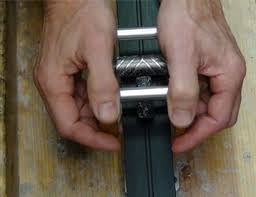The other factor that contributes to deciding what wax
to use is moisture content. Before going further, it
is important to understand that as a ski passes over
snow, the friction at the tip melts a very small
amount of snow and creates a little water under the
ski. The warmer the snow is, the wetter the snow is
and the more water is in contact with the base of the
ski. Water content in the snow affects the ski speed
in several ways:

https://www.google.com/search?q=ski+wax+structure&espv=2&biw=849&bih=439&source=lnms&tbm=isch&sa=X&ei=37U1Ve-
1. Liquid
water is attracted to the paraffin. This can be seen
when water beads on wax paper or other waxed surfaces.
The attraction between the water and
the wax is overcome by mixing fluoro into the
paraffin. This additive makes a fluoro carbon wax,
which now repels snow and water.
2. The liquid
water under the ski has surface tension, which creates
a suction force between the ski and the snow/ water
beneath.
Stamping or grinding small groves in the base of the
ski can counter the suction force. These groves
provide tinny channels that shed water from beneath
the ski keeping it from building up and sucking the
ski to the snow thus increasing the force countering
the ski movement. The two pictures depict how
structure is applied and what patterns there are to
use.

https://www.google.com/search?q=ski+wax+structure&espv=2&biw=849&bih=439&source=lnms&tbm=isch&sa=X&ei=37U1Ve-